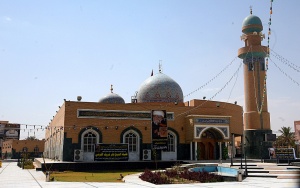Al-Hannana Mosque: Difference between revisions
(Created page with "'''Al-Hannana Mosque''' (Arabic: مسجد الحَنّانة) located in the north of Najaf, Iraq is among places at where the salutation of Hussain ibn Ali|Imam Hus...") |
No edit summary |
||
| Line 2: | Line 2: | ||
== The Name of the Mosque == | == The Name of the Mosque == | ||
[[File:Al-Hannana Mosque.jpg|thumb|right|Al-Hannana Mosque, [[Najaf]], [[Iraq]]]] | |||
According to [[Shiʿa|Shi’ite]] tradition, this site mourned for [[Ahl al-Bayt]] twice: during the funeral procession of [[Imam Ali]] and after the [[Battle of Karbala]]. That is the reason the mosque was named Hannana (weeper/mourner). | According to [[Shiʿa|Shi’ite]] tradition, this site mourned for [[Ahl al-Bayt]] twice: during the funeral procession of [[Imam Ali]] and after the [[Battle of Karbala]]. That is the reason the mosque was named Hannana (weeper/mourner). | ||
Latest revision as of 13:29, 1 November 2020
Al-Hannana Mosque (Arabic: مسجد الحَنّانة) located in the north of Najaf, Iraq is among places at where the salutation of Imam Hussain is recommended. It is related that the sacred head of Imam was kept there. Moreover, Shaikh Mufid, Sayyid Ibn Tawoos and Shaheed al Awwal relate in the chapter of the pilgrimage of the Commander of the faithful, that when you reach a place called Hannanah, recite two units of Prayers.
The Name of the Mosque[edit | edit source]
According to Shi’ite tradition, this site mourned for Ahl al-Bayt twice: during the funeral procession of Imam Ali and after the Battle of Karbala. That is the reason the mosque was named Hannana (weeper/mourner).
Imam al-Sadiq’s Prayer at al-Hannana Mosque[edit | edit source]
Muhammad bin Abi Umayr relates from Mufazzal bin Umar, that he said, that when Imam Ja’far al-Sadiq reached a bent pillar in route to Ghariyy (old name of Najaf), he recited two units of Prayers there. I asked him, “What Prayer is this?” He replied, “This is the site where the head of my grandfather Imam Hussain was kept. When they came from Karbala, they kept the sacred head here and then took it to the presence of Ubaydullah, the accursed, from here”.[1]
Source[edit | edit source]
Refrences[edit | edit source]
- ↑ Nafasul Mahmum, p. 305
